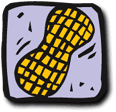|
Many people avoid eating peanuts and other nuts because of their high fat content; however, a large body of evidence also associates nut consumption with a reduced risk of coronary heart disease (CHD).
Using data collected in a continuing food survey from 1994-1996, researchers sorted respondents by “use” or “nonuse” of peanuts. Data were based on a national sample of 14,262 men, women and children who completed two-day food intake records. Differences between peanut users/nonusers were analyzed relative to energy and nutrient intake, health eating index (HEI) scores, and body mass index (BMI). Peanut consumption included peanuts, peanut products, peanut butter, peanuts as part of a sweet snack, peanuts as part of a savory snack, and peanuts or peanut oil as ingredients in a meal.
 Respondents tended to have generally good diets, with higher HEI scores among individuals consuming peanuts than non-consumers. Results demonstrated improved diet quality of peanuts users indicated by higher vitamin A, vitamin E, folate, calcium, magnesium, zinc, iron and dietary fiber intake, and lower intake of saturated fat and cholesterol. Energy intake was significantly higher for peanut users compared with nonusers, and BMI was lower in users compared with nonusers. Respondents tended to have generally good diets, with higher HEI scores among individuals consuming peanuts than non-consumers. Results demonstrated improved diet quality of peanuts users indicated by higher vitamin A, vitamin E, folate, calcium, magnesium, zinc, iron and dietary fiber intake, and lower intake of saturated fat and cholesterol. Energy intake was significantly higher for peanut users compared with nonusers, and BMI was lower in users compared with nonusers.
Conclusion: "In summary, the results of the present study have shown that peanuts and peanut products enhance the nutrient profile of the diet,” note the authors. “Moreover, inclusion of this energy dense food can be done in a manner that does not result in weight gain provided that energy intake does not exceed energy expended over time. … Encouraging the use of peanuts and peanut butter, both popular and familiar foods, gives additional options that may promote adherence to a healthy diet that reduces risk of chronic disease.”
So go nuts! And remember that peanuts are relatively high in protein, which means that in addition to the health benefits, they are a satisfying snack.
Reference:
Griel AE, Eissenstat B, Juturu V, et al. Improved diet quality with peanut consumption. Journal of the American College of Nutrition 2004;23(6): 660-68.
For more information about good nutrition, go to https://www.chiroweb.com/find/archives/nutrition.
|



